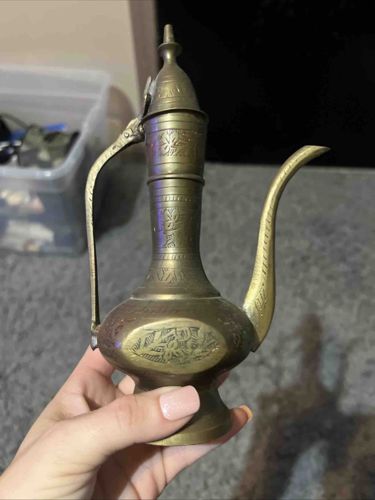
Engraved Brass Ewer/Aftaba
This item is an antique or vintage Middle Eastern/Indian brass ewer or possibly a form of 'aftaba' (a traditional vessel for pouring water). It is primarily constructed from brass, exhibiting a warm, aged patination that suggests considerable age and use. The ewer is characterized by its elongated, slender neck topped with a hinged, pointed lid, typical of a pouring vessel. The lid features a small, finial-like protrusion at its apex and is decorated with an engraved band of repeating patterns, possibly floral or geometric motifs. The handle is slender and gracefully curved, attaching to the upper body and extending downwards. It appears to be riveted or otherwise securely affixed to the body. The spout is similarly curved and elongated, tapering to a narrower opening for controlled pouring. The primary body of the ewer is ovoid or globular, sitting atop a distinct pedestal base which flares slightly for stability. One of the most notable features is the intricate engraved decoration covering a significant portion of the body. These engravings consist of stylized floral designs and possibly calligraphic elements, arranged within elongated cartouches or bands around the widest part of the vessel. Similar engraved details are also visible on the neck and along the handle and spout, indicating consistent craftsmanship throughout. Visible condition issues include a general darkening and unevenness of the patination, consistent with brass that has aged naturally over time. There are no immediate signs of significant dents or structural damage, though minor surface abrasions or scratches are likely present given its age and material. The hinged lid appears functional. The quality of the engravings suggests a level of detail and care in its manufacture, typical of artisan-made goods from the region. While no distinct maker's marks are visible in the provided image, the style, material, and decorative motifs strongly point to a 19th or early 20th-century origin, likely from India or the wider Middle East.
AI-Generated Appraisal Disclaimer
Estimated Value
$300-500
Basic Information
Category
Decorative Arts
Appraised On
December 7, 2025
Estimated Value
$300-500
Item Description
This item is an antique or vintage Middle Eastern/Indian brass ewer or possibly a form of 'aftaba' (a traditional vessel for pouring water). It is primarily constructed from brass, exhibiting a warm, aged patination that suggests considerable age and use. The ewer is characterized by its elongated, slender neck topped with a hinged, pointed lid, typical of a pouring vessel. The lid features a small, finial-like protrusion at its apex and is decorated with an engraved band of repeating patterns, possibly floral or geometric motifs. The handle is slender and gracefully curved, attaching to the upper body and extending downwards. It appears to be riveted or otherwise securely affixed to the body. The spout is similarly curved and elongated, tapering to a narrower opening for controlled pouring. The primary body of the ewer is ovoid or globular, sitting atop a distinct pedestal base which flares slightly for stability. One of the most notable features is the intricate engraved decoration covering a significant portion of the body. These engravings consist of stylized floral designs and possibly calligraphic elements, arranged within elongated cartouches or bands around the widest part of the vessel. Similar engraved details are also visible on the neck and along the handle and spout, indicating consistent craftsmanship throughout. Visible condition issues include a general darkening and unevenness of the patination, consistent with brass that has aged naturally over time. There are no immediate signs of significant dents or structural damage, though minor surface abrasions or scratches are likely present given its age and material. The hinged lid appears functional. The quality of the engravings suggests a level of detail and care in its manufacture, typical of artisan-made goods from the region. While no distinct maker's marks are visible in the provided image, the style, material, and decorative motifs strongly point to a 19th or early 20th-century origin, likely from India or the wider Middle East.
Related Tags
Get Your Items Appraised
Instant estimates of your treasures with AI-powered instant appraisals